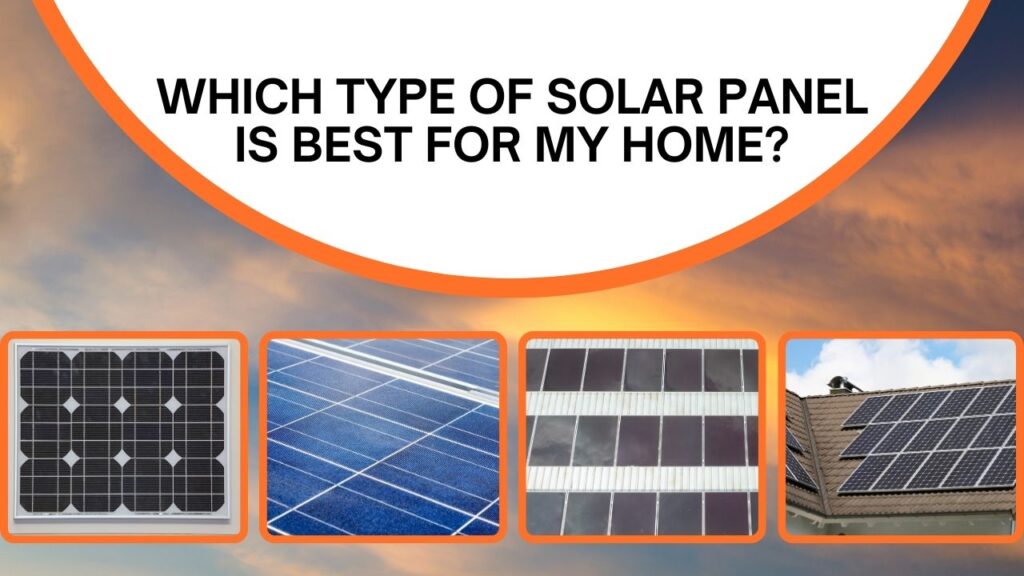Deciding Which Type of Solar Panel is Best for Your Home
Installing solar panels in Brisbane is one of the best investments you can make for both your home and the environment. But with so many types of solar panels on the market, how do you choose what’s best for your home? This article will guide you through the four main types of solar panels, the pros and cons of each, and provide tips to determine which is the right solar solution for your house.
Table of Contents
ToggleThe 4 Main Types of Solar Panels
There are four primary categories of solar panels available:
- Monocrystalline Solar Panels.
- Polycrystalline Solar Panels.
- Thin-Film Solar Panels.
- Bifacial Solar Panels.
- P-Type vs N-Type Solar Panels
Let’s look at how they compare.
1) Monocrystalline Solar Panels
Monocrystalline solar cells, also called single-crystal silicon, are made from cylindrical silicon ingots, giving them a distinctive uniform black appearance. Some key attributes are:
Pros:
Highest efficiency rate, usually around 15-20%. Smaller surface space is needed for energy output. Performs better in low-light environments. Long lifespan of 25-30 years
Cons:
Most expensive option ($3.00+ per Watt)
2) Polycrystalline Solar Panels
Polycrystalline solar cells are made of molten silicon formed into perfectly square shapes. Key details include:
Pros:
Lower price point than monocrystalline ($0.90 – $1.50 per Watt). Only slightly lower efficiency rate of 13-16%
Cons:
Larger surface area required for equivalent output. Can degrade faster than monocrystalline in hot climates
3) Thin-Film Solar Panels
Thin-film PV cells are made by applying semiconductor material onto substrates like glass or stainless steel. Pros and cons:
Pros:
Very affordable compared to crystalline solar panels. Performs better in partial shade and cloudy weather
Cons:
Much lower efficiency rate of 7-13%. Requires a lot of installation space for meaningful energy output
4) Bifacial Solar Panels
Bifacial solar modules absorb light on both sides – the front side glass and rear transparent backing. Here’s how they compare:
Pros:
Increased total energy production compared with traditional panels. Can generate up to 25% more energy from albedo effect
Cons:
More expensive than monofacial equivalents. Site conditions can limit bifacial gain
5) P-Type vs N-Type Solar Panels
Solar cells are made by doping silicon with other materials to create a positive and negative layer – called the P-type and N-type layers respectively. Traditionally, solar panels have used P-type cells with a positively charged layer on top. However, N-type cells are becoming more popular.
N-Type Solar Panels
Pros:
- Higher efficiency than p-type, typically 22-24%
- Better temperature coefficients for improved performance in hot climates
- Less light-induced degradation over time
Cons:
- More expensive manufacturing process
- Newer technology with a slightly shorter proven track record
P-type solar panels are still more prevalent, but N-type is the latest and most advanced solar cell technology. Many premium residential solar panels now use N-type cells to achieve their higher efficiency ratings.
Which is Best For My Home?
With the introduction to all four primary solar panel types completed, how do you determine which technology is right for your house?
Here are 5 key factors to help select the best solar panels:
1. Your Available Space Consider the total roof or ground placement area you can allot solely for your solar array when selecting a system. Thin-film and polycrystalline panels require around 30% more surface area than monocrystalline to produce the same output. If space is limited, choose efficient monocrystalline or bifacial panels.
2. Sun Exposure Determine how much full sun versus shade your usable solar location gets throughout the day and year. If partly or often shaded, thin-film amorphous panels will suffer the least energy losses. Frequent low light conditions also favor highly efficient monocrystalline modules.
3. Local Climate Conditions:-The climate and average temperatures where you live should guide your solar technology selection. In hot environments, monocrystalline silicon panels will outperform cheaper polycrystalline models that degrade faster in sustained heat. Cold weather favors standard monocrystalline or bifacial for snowy albedo gains.
4. Azimuth Orientation:- The direction your panels face matters. South-facing roofs allow standard monofacial panels to get the highest net energy gain annually. For east/west-facing arrays, bifacial panels can offset performance losses by leveraging reflective ground surface area.
5. Budget Saving money is a priority for most homeowners. So focus first on quality mid-range products to meet your needs at the best value. Typically polycrystalline silicon panels offer this sweet spot. But don’t compromise too much on efficiency and durability to save on upfront costs.
Always verify that any solar panels you’re considering have an IEC 61215 certification and 10-25-year manufacturer performance warranty as reassurance of reliability. No matter what technology you invest in, the environmental and financial benefits of going solar are immense. Solar panels can provide clean electricity for your home for decades while increasing property value. Given the incentives and advancing panel efficiencies, now is the best time to join millions of homeowners choosing to go solar.
There are lots of great reasons to go solar – from slashing electric bills to achieving energy independence to reducing your carbon footprint like Solar Thoughts is Expert solar energy company in Brisbane. Hopefully this guide gives you confidence that by carefully weighing a few key criteria like climate, space and budget – you’ll pick the ideal solar panel type to serve your household for 25-30 years.
I welcome any feedback, or additional questions in the comments, and would be glad to provide any guidance I can to help you successfully navigate your solar journey!
Solar Energy The Smart Way to Power Your Home






